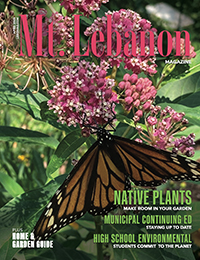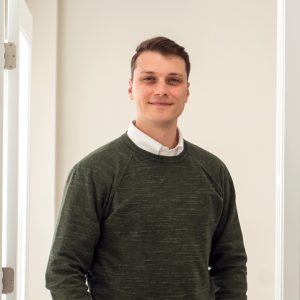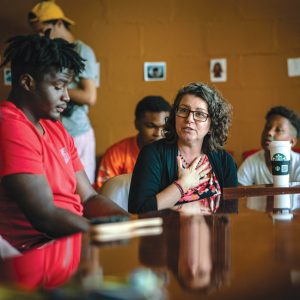For the Love of Tennis

Whether you’re picking up a tennis racket for the first time or were practically born with one in your hand, Mt. Lebanon Tennis Center has something for you. Located on Cedar Boulevard at the entrance to Mt. Lebanon Park, the center offers singles and doubles play, lessons, leagues and tournaments for beginners to high-level competitive players.
Regardless of where you fall on the ability continuum, you’ll be playing at a center that has received the United States Tennis Association’s (USTA) Outstanding Facilities Award and is recognized as a USTA Premier Tennis Provider in the Middle States region for its innovative programming for all ages and efforts for growing and promoting tennis.
You’ll also be playing on Mt. Lebanon’s historic clay courts, which in addition to offering casual play, have hosted many amateur and professional tournaments dating back to the 1960s, when tennis really took off in this area.
Tennis began in Mt. Lebanon as a backyard sport—the original private court that belonged to first Mt. Lebanon solicitor, Samuel Schreiner, still exists behind the house he built on St. Clair Circle in 1929. Over the years, however, the sport grew in popularity—both to play and to watch. Mt. Lebanon Recreation Department, in partnership with Indoor Tennis of Mt. Lebanon, has been able to expand from one scruffy public court to the 15 well-maintained courts we now enjoy, including six with winter “bubbles” that provide year-round play. In addition, we have viewing stands and a tennis center building with a community room and a pro shop.

Playing on Clay
Truth be told, we say we have clay courts but clay courts are largely a thing of the past. Mt. Lebanon’s green clay courts are made of a material called Har-Tru, crushed metabasalt, pre-Cambrian rock found in Virginia’s Blue Ridge Mountains. Har-Tru is installed over a permeable stone base that allows courts to drain more quickly after
a rain.
Har-Tru first became available in the early 1930s, but at that time a material composed of crushed red brick was more commonly used to replace the old-style clay courts. By the late 1970s, however, most of the red clay courts in America, including Mt. Lebanon’s, had been converted to Har-Tru green.
Tennis can be played on various soft and hard surfaces, grass, carpet (indoor), clay and hard (basically asphalt or concrete with a layer of padding). Har-Tru “clay” courts are a sort of compromise between hard and soft surfaces—more expensive and requiring more maintenance than concrete or asphalt,
but comfortable enough that players are willing to pay to play on it.
“Clay courts, and specifically Har-Tru courts, are much easier on a person’s body,” says head tennis pro Hughes. “The softness of the clay courts is easier on a person’s knees and joints. We have all ages playing here, but our biggest group is the older crowd, 50 years older and up, because they love our clay courts.”
 The Har-Tru surface also slows the speed of play, making it literally a different ballgame. “The ball bounces differently on clay,” says Hughes. “The points are longer since the courts are slower, and there is more mental strategy when playing on clay.”
The Har-Tru surface also slows the speed of play, making it literally a different ballgame. “The ball bounces differently on clay,” says Hughes. “The points are longer since the courts are slower, and there is more mental strategy when playing on clay.”
“One of the reasons tennis remains strong in Mt. Lebanon when it has declined in other areas is our courts,” says Recreation Director David Donnellan. “There are hard courts in Mt. Lebanon that people can walk up and play on for free, and that’s great, but for many people, only clay courts will do. We want to provide the facilities and services our residents expect. It’s more work, but it is well worth it.”
Back when our courts were real clay, The National Collegiate Clay Court West Penn Amateur Championship, known informally as “The West Penn,” was played here. The oldest collegiate tournament in the country, it began in Pittsburgh in 1889 and moved from place to place around the area, eventually settling in Mt. Lebanon in 1967. During the tournament’s peak years, Mt. Lebanon residents had the chance to see emerging talents who later went pro, including Vitas Gerulaitis, who went on to win the Australian Open, and Peter Fleming, who partnered with John McEnroe to win three U.S. Opens and four Wimbledon championships.
People also cheered for local favorites who learned the game on our courts and later played on the pro circuit: Berta McCallum Russo, who rose as high as 26th in the world in singles and is in the Middle States Hall of Fame along with Billie Jean King, Gretchen Rush Magers, who won top-level singles titles at Auckland, Schenectady and Moscow and reached the quarterfinals at Wimbledon and the U.S. and French Opens, and Don Johnson, who won both the Wimbledon men’s doubles and mixed doubles titles.
The “West Penn” has since moved on, but Mt. Lebanon still hosts a first-class competition. The USTA Pro Circuit added Mt. Lebanon’s clay courts to its schedule of tournaments 19 years ago. A USTA men’s tournament, part of the Competitive Pathway program that provides players with opportunities to gain professional points needed to compete on the major pro tours, is slated here July 2 to 7. Like the West Penn, it’s a chance to see players you’ll likely be hearing more about later. Matches go on all day, and admission is free. Last year’s tournament was won by Argentinian Mateo Nicolas Martinez, ranked 707th worldwide by the ATP.

Playing in the Bubble
One reason local young players have been able to compete with players from warm climates with year-round play is because a group of visionary players in the mid-1960s sought an alternative to spending their winters playing badminton in a gym. In 1967, Martin Tressel, Paul Tillotson, Frank Wiegand, Tom Halloran and Bob McCallum led the effort to incorporate Indoor Tennis for Mt. Lebanon. They got 25 other tennis lovers to pledge $1,000 each for a total of $30,000—equivalent to around $226,000 today—to purchase a canvas tennis “bubble” that could be lighted and heated and could cover a court. Upkeep would be split between Indoor Tennis, a private entity, and the municipality. The founders’ promissory notes yielded a loan from Union Trust Bank, and user fees from Indoor Tennis subsequently provided enough income that none of those who pledged ever needed to put up any money. Neither did the taxpayers.
The original bubble was booked all winter long and all the next winter, making a great case for purchasing a second bubble in 1969 and a third in 1972. For each purchase, there was no shortage of backers willing to pledge the cash if needed.
Now the bubbles cover six courts and Indoor Tennis for Mt. Lebanon is still partnering with the municipality after more than 50 years. “Indoor” has spent $1.3 million on the bubbles, as well as on improvements to the courts and the construction of the tennis center building in 1994.
This month, the bubbles will come down with labor supplied by the high school wrestling and tennis teams, and preparation of the “clay courts” for the outdoor season—private and group lessons, clinics and team tennis for kids and adults, and the July tournament, will begin.
“We are looking forward to warmer weather when we can welcome everyone back to our one-of-a-kind tennis center,” Donnellan says.

Mt. Lebanon Tennis Center on Cedar Boulevard has 15 courts, 10 lighted for evening play. Six courts are enclosed by heated bubbles to allow for year-round play in any weather.
Head pro Hank Hughes oversees all operations. Hughes is certified at the highest levels of the United States Tennis Association (USTA) and the Professional Tennis Registry. He has served as president of the USTA Middle States Region and has been named the Pro of the Year by the Allegheny Mountain Division of the USTA, which encompasses 24 counties in western Pennsylvania and four counties in West Virginia.
The center draws 12,000 players annually. About 1,000 adults and children participate in one or more of 100 tennis programs the recreation department plans. There are private and group lessons for adults and children. Junior tennis clinics, with six or seven students per instructor, range from beginner classes for 5- and 6-year-olds to tournament training for 10- to 17-year-olds. Players with a USTA rating of 3.0 to 4.5 may play in leagues. (If you don’t have a USTA rating, pros at the tennis center can evaluate you and assign one.)
Tennis center hours from early May through the end of September are 7:30 a.m. to 10:30 p.m. daily. Rates range from $6 to $8 an hour, and season passes are available from $129 for residents under 19 to $299 for nonresident adults. Purchase permits now at the Rec Center or Ice Rink or after May 1 at the tennis center. Reserve courts for play at 412-343-3111. For more information, visit www.mtlebanon.org. Municipal courts at Meadowcroft and Williamsburg parks offer free play, no reservations required.
Indoor Tennis operates the bubbles from October 7-April 8. Permits range from $500-$800; hourly rates are from $21-32. For more information, visit www.indoortennis.bradleybrowndesign.com





